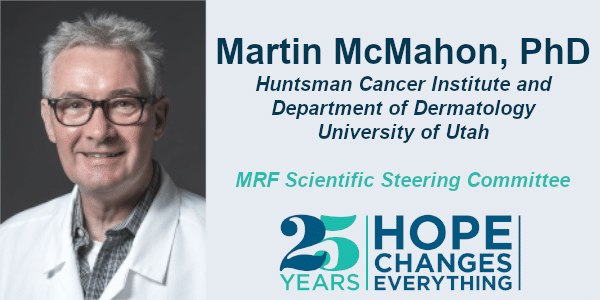News & Press
25th Anniversary: A Mouse Model in BRAF-induced Melanoma
Guest blog post by Martin McMahon, PhD, Senior Director of Preclinical Research, Principal Investigator at Huntsman Cancer Institute. Dr. McMahon received the Diana Ashby Senior Investigator Award (in memory of Linda A. Transou) in January 2006 and serves on the MRF Scientific Steering Committee.
Having worked on RAF family kinases for over 10 years, the revelation of frequent mutations of BRAF in numerous human cancers, especially in melanoma, was manna from heaven. David Dankort, a postdoctoral fellow in my lab in the UCSF/Diller Comprehensive Cancer Center, was immediately galvanized into the generation of a genetically engineered mouse (GEM) model in which cancers driven by the BRAFV600E oncoprotein kinase could be studied. Inspired by the work of MIT’s Dr. Tyler Jacks, Dr. Dankort generated BrafCA mice in which BRAFV600E could be expressed in any mouse tissue or organ. Moreover, his initial work clearly indicated that expression of BRAFV600E in mouse lung could initiate tumorigenesis. However, in order to generate a GEM model of BRAFV600E-driven melanoma we needed a way to express the oncoprotein solely in the melanocytes of adult mice, and we also needed a source of “high-risk/high reward” funding to support this research. Hence, in the fall of 2005 I applied for the MRF’s Diana Ashby Senior Investigator Award and, to my delight and amazement, was selected as the awardee in early January 2006.
Experiments conducted in the first year of funding revealed what we had suspected: expression of BRAFV600E during mouse embryogenesis was lethal. Hence, we needed a way to activate BRAFV600E expression in melanocytes of adult mice. To achieve this, in a collaboration brokered by Dr. Lynda Chin, we teamed up with Dr. Marcus Bosenberg, who was on the faculty at the University of Vermont. As a postdoc in Lynda’s lab, Marcus had generated precisely the mouse that we needed (Tyr::CreERT2) but, since he was also very interested in GEM models of melanoma, we agreed to exchange our key mouse strains and to work in parallel on generating the models. Over the course of the next few years our efforts to generate various models of BRAFV600E-driven melanoma were very successful and resulted in numerous high impact publications. Moreover, BRAFV600E-driven melanoma cell lines derived from the various GEM models proved to be a useful complement to the use of the primary models. My first public presentation of a “New mouse model of BRAFV600E-driven melanoma” was at the Society for Melanoma Research annual congress in Nordwijk in the Netherlands in September 2006. However, it took almost two more years before the paper describing our research was published in Nature Genetics – such are the timelines of success in academia! The model that we described was complemented by separate models from the labs of Frank Haluska and Richard Marais, which confirmed that BRAFV600E could initiate melanomagenesis in the mouse, but that additional genetic events were required for progression to full-blown malignancy. Moreover, others including my Huntsman Cancer Institute colleague, Dr. Sheri Holmen, have gone on to describe events that promote broader metastatic dissemination of BRAFV600E-driven melanoma. Finally, the original models have been adopted by numerous labs both in the public and private sector, where they have proven very useful in exploring mechanisms of sensitivity or resistance to chemo- or immunotherapy.
It is hard to overestimate the impact of the MRF/Diana Ashby award in the development of our model of BRAFV600E-driven melanoma. At the time, there were reasons to believe that BRAFV600E might simply be a driver of benign mole formation and might simply be a bystander in the process of melanomagenesis. Moreover, the early-stage development of new GEM models of human cancer was not something that the National Cancer Institute was generally willing to fund. Hence, it took some foresight and confidence on the part of the MRF and its various grant reviewers to select our application for funding. Indeed, to this day I do not know who served on that MRF study section and selected my application for funding. Consequently, I would like to extend my thanks 16 years after the fact to the MRF and its grant reviewers for having taken a chance on my application. I hope that the obvious impact of our research over the years has justified your decision to fund such high-risk/high reward research.
Life-saving advances in melanoma research are made possible by the generosity of supporters like YOU. Please consider a tax-deductible donation today:


